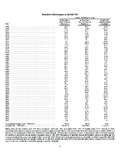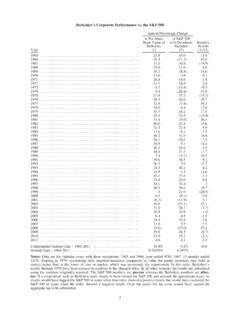Transcription of STRATEGIES USED BY WARREN BUFFET, CHARLES …
1 STRATEGIES used BY WARREN buffet , CHARLES MUNGER, AND SHELBY DAVIS TO OUTPERFORM THE MARKET Presented to the Michigan Tech Applied Portfolio Management Program 1 Houghton, Michigan April 21, 2010 Stocks have been one of the worst performing asset classes in the last decade, underperforming gold, commodities, crude oil, bonds, and treasuries. In the decade ending January 1, 2010, the average stock as measured by the Standard & Poor s 500 Index actually declined per year. The accompanying chart, courtesy Joshua Brown and Bloomberg, illustrates the return of stocks versus other asset classes. And the Wall Street Journal pointed out last year that equities are in the lost decade tarnishing their image with investors. The S&P 500 index is composed of 500 of the largest and most successful companies that operate on a global basis and the index is used by many active portfolio managers as a performance benchmark. So it is a good proxy for the overall market.
2 Long term investors, hoping to harvest returns from the market, have had slim pickings over an extended period. Many have fled the stock market. Further, there is a growing consensus among investment advisors and professionals that active portfolio managers that is managers who pick and choose stocks for their portfolio tend to under-perform the major market averages. There is some statistical validation of this One measurement of a money manager's excess returns is referred to as alpha . It is defined as the added returns an investor receives over and above the returns you would expect from the market. Bill Donoghue, Editor of The Proactive Fund Investor, recently year reviewed 3,226 actively managed mutual funds and found the average alpha was a negative Donoghue s results indicate that active portfolio managers are delivering returns below what you would expect from the market. In fact, investors overall were penalized from a return standpoint by investing in actively managed funds.
3 This finding was not unique. Some active managers have pushed the legal boundaries in an attempt to obtain information or an advantage in generating excess returns. Studies like Donoghue s explain why many investment advisors recommend individuals consider low cost exchange traded funds (ETF s) that track the major market averages. Statistically, the advisors argue this low cost passive method of investing generally outperforms many STRATEGIES that rely on actively managed portfolios. Other recent studies confirm that active portfolio managers have a very difficult time beating the major market averages and it appears that it is becoming more difficult for professional money managers to generate alpha (excess returns) over time. Some claim this is because the markets are becoming more global and more efficient. Others claim transactional, marketing, regulatory, and management costs overwhelm any excess returns an active manager can generate.
4 Ms. Anderson & The Othmers: A WARREN Buffett Case Study. In September, 2007, the George School, a preparatory school in Bucks County, Pennsylvania, received a $128 million donation from Barbara Anderson, an alumna of the high school. The administrators of the private, 500-student institution set on a 240-acre campus were stunned. 1 This presentation is for the sole use and benefit of undergraduate finance students at Michigan Technological University s Applied Portfolio Management Program. 2 See: The Little Book of Common Sense Investing: The Only Way to Guarantee Your Fair Share of Stock Market Returns , (Wiley Publishing 2007) by John C. Bogle. MTU APMP Presentation - - 2 - Ms. Anderson, who now lives in Fresno, California, is a retired kindergarten teacher. Her parents were well educated but not considered wealthy. At 75, and diagnosed with Alzheimer s, she wanted to make the gift to the school for the education she received and the work ethic the school encouraged.
5 Separately, living quiet, unpretentious lives Dr. and Ms. Othmer he was a professor of chemical engineering at Polytechnic University in Brooklyn and she was a former grade school teacher - died in the late 1990 s. They had no children. When the Othmers died, friends were shocked to learn that their estate was worth close to $800 million. What is the connection between the Othmers and Ms. Anderson? How did these teachers acquire so much wealth? In Ms. Anderson s case, her father happened to be a finance professor at Columbia University. He became well known in academic circles for the textbook he co-authored with another professor entitled Security Analysis . His name was David L. Dodd. The co-author was a professor named Benjamin Graham. The textbook sales generated a good profit, but did not make either wealthy. A prospective student who had been rejected from Harvard s MBA program wrote to Dr. Dodd in 1950: I thought you were dead, but now that I know that you re alive, I d like to come study with you.
6 That student was admitted to Columbia, eventually graduating. Dodd invested for himself and his daughter in a private investment partnership managed by his young student. The student s name was WARREN Buffett. The investors were eventually given the option of liquidating their investment when the partnership dissolved or taking Berkshire Hathaway shares priced in the open market under $50 per share. Dodd elected to take the shares. The Othmers, like many long term investors, invested their money into small, well managed, undervalued companies. Like the Dodds, the Othmers had an additional benefit: in the early 1960 s they each invested $25,000 in a private investment partnership run by WARREN Buffett. The Othmers received thousands of shares of Berkshire Hathaway at $46 a share (chart at right) when Mr. buffet dissolved his partnership. Today those shares trade around $125,000 a share. Mrs. Othmer's shares were worth $578 million on her death; her husband's, sold on his death when the price was lower, were worth $210 million.
7 Mr. Buffett managed a private investment partnership from 1957 until roughly 1969. When he shut down the partnerships investors could either cash out or roll over their investment into Berkshire Hathaway. Those who cashed out did very well. Over a 13 year period Buffett outperformed the market by an average before his costs, fees, and expenses. Those that rolled their investment over to Berkshire Hathaway did incredibly well. 3 General Lessons for Investors An investment manager that can outperform the market has an incredible impact on total long term returns STRATEGIES that have a high probability of outperforming the market are extremely valuable to investors with a long term time horizon Time is one of an investor s most valuable assets Even small differences in annual returns can have enormous longer term impact on total returns due to compounding 4 You don t have to be a Harvard MBA to be a successful money manager 3 Buffett started his first private investment partnership in 1957.
8 He convinced a number of Omaha individuals to invest $25,000 each. Buffett put in $100 of his own money, appointed himself general partner and began to purchase small undervalued stocks. His goal was to beat the Dow Jones Industrial Average by an average of 10% a year. When he dissolved the partnership in 1969 Buffett's investments had ballooned at a compound rate of annually, compared to just annually for the Dow. The return on Buffett s initial $100 investment would certainly be described as incredible . Mr. Buffett is currently Chief Executive Officer of Berkshire Hathaway (NYSE symbol: BRKA). 4 Had Mr. & Mrs. Othmer invested in the S&P 500 index instead of with Mr. Buffett they would have an account worth roughly $ million (a return of around a year) very impressive. But not anywhere near the almost $800 million obtained with Mr. Buffett (annual returns of around ) MTU APMP Presentation - - 3 - Buffett s Rules for Investment Success A summary of the investment STRATEGIES utilized by WARREN Buffett were published by a law professor at Cardozo University.
9 Entitled "The Essays of WARREN Buffett: Lessons for Corporate America" it is a compilation of Buffett's annual reports and other communications. Some of Buffett's investment STRATEGIES are as follows: 1. Buy a Good "Business Boat" - Buffett points out the importance of choosing a company situated in a growing and profitable industry. He identifies his largest investment mistake - buying the small company his firm was named after (Berkshire Hathaway) - not because the company was flawed, but because the industry it was in (textiles) was so unattractive. The company was cheap by most valuation metrics, but there was a good reason. The textile industry provided very meager returns for Berkshire. No matter how well managed the company was it would always have subnormal returns. The textile industry was a commodity business, competitors had facilities located overseas that were low cost producers, and substantial excess capacity existed worldwide.
10 Buffett notes "a good managerial record (measured by economic returns) is far more a function of what business boat you get into than it is of how effectively you row .. Should you find yourself in a chronically-leaking boat, energy devoted to changing vessels is likely to be more productive than energy devoted to patching leaks." 2. Compound Returns by Deferring Taxes - One reason that investors in Berkshire stock did so well was that their investment was compounded and their capital gains taxes were never realized. "Tax-paying investors will realize a far, far greater sum from a single investment that compounds internally at a given rate than from a succession of investments compounding at the same rate. But I suspect many Berkshire shareholders figured that out long ago" according to Buffett. 3. Concentration of Investments - Professor Cunningham notes that "contrary to modern finance theory, Buffett's investment knitting does not prescribe diversification.


